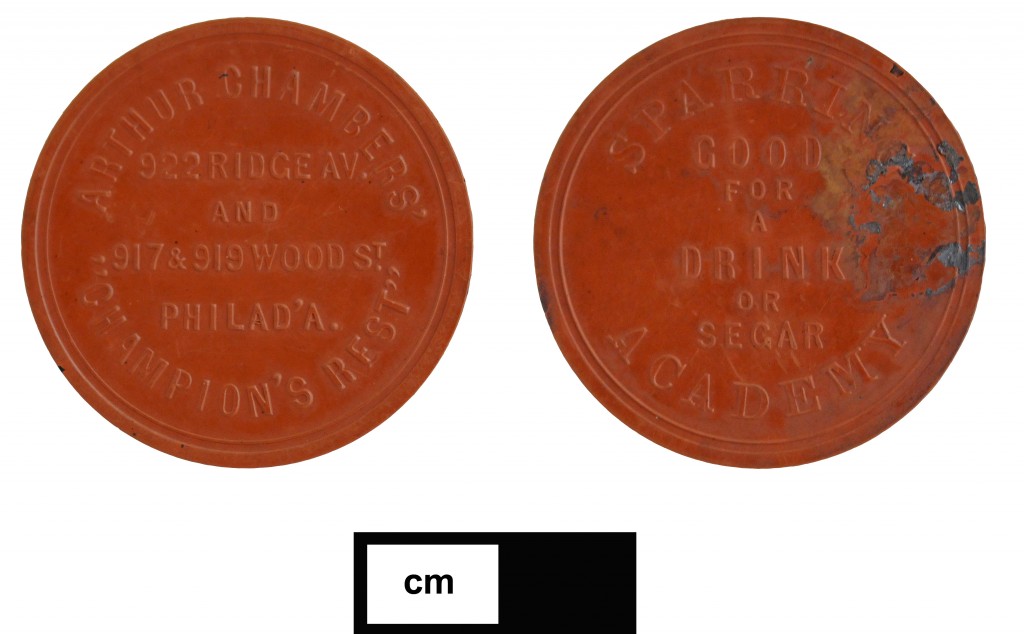MAY 2013 — ARTIFACT OF THE MONTH
Back to Main Page…
Artifact of the Month Index
“Champion’s Rest” Saloon Token
 Obverse and reverse sides of the Champion’s Rest saloon token.
Obverse and reverse sides of the Champion’s Rest saloon token.
This red vulcanite token was recovered during excavations along I-95 in the Fishtown section of Philadelphia. The front, or obverse, side reads: “ARTHUR CHAMBERS’ / 922 RIDGE AV. / AND 917 & 919 WOOD S.T / PHILAD’A. / CHAMPION’S REST”, while the back, or reverse, contains: “SPARRING / GOOD / FOR / A / DRINK / OR / SEGAR / ACADEMY”. Produced by the “Champion’s Rest” boxing saloon to be used as change for its patron’s payments, this token would have been in circulation sometime between 1875 and 1896, the saloon’s approximate period of operation. Providing change that could only be used at the “Champion’s Rest” ensured that patrons would have to return to cash in their tokens.
Located at the intersection of Ridge Avenue and Wood Street in the city’s 13th Ward, and operated by retired bare-knuckle boxer Arthur Chambers, the “Rest” became notorious for its disreputable patrons and frequent disturbances. Loud music and singing were common in the saloon, which was also an “infamous den” for women of “very bad character”. Viewed by contemporaries as a resort for a very low class of people, the saloon apparently was of little nuisance to those who lived nearby, as one witness described that nothing “short of an earthquake would create a disturbance in that neighborhood.” Despite a floor that was consistently in a “slimy condition”, drunken singing that was “not of a sentimental character,” and a reputation for thievery and belligerence, in 1885 the “Champion’s Rest” also proclaimed to be the “Acknowledged Sporting Resort in America,” and advertised sparring exhibitions on the weekends and a “handsomely furnished, well ventilated and well lighted Pool Room” next door.
Born in Lancashire, England, in 1847, Arthur Clarke Chambers, who stood just 5’4” tall, began his professional boxing career in 1864 after a period of service in the Royal Navy. Chambers immigrated to America in 1871 with his wife Ellen Bunn and daughter Agnes, and soon after became the lightweight Champion of America by defeating Billy Edwards in 1872, despite being bitten by Edwards during the fight. Chambers retired for two years in 1877 after having his left middle finger amputated, but returned to reclaim his title in what many consider to be the first great lightweight bout in history. In 1879 he defeated American Johnny Clark by knockout in a herculean 136-round fight. Chambers’ victory over Clark remains the longest boxing match on record between international opponents.
In retirement Chambers became a financial backer for future heavyweight champion John L. Sullivan, the “Boston Strong Boy,” and even featured one of Sullivan’s early fights at the “Champion’s Rest.” In 1880 Chambers lived with his wife, daughter, and “Rest” bartender John McCabe at 922 Ridge Avenue while operating the saloon downstairs. Failure to obtain a liquor license ultimately forced his bar to close around 1896.
Though details are sparse, the years following the closing of the “Champion’s Rest” seem to have been a lonely and tragic period for Chambers. By 1900 he was estranged from his family and lived alone in a rental property behind 157 N 9th Street, not far from the former location of the “Rest.” At that time, his wife Ellen was living with daughter Agnes and son-in-law Walter Campbell on Oxford Street in Frankford. In 1910, while still at 157 N 9th Street, Chambers was living with Chinese immigrant Moy Wong, Wong’s American wife Margaret, and their three children. Identified as an interpreter, Moy Wong likely served as an intermediary between Chinese residents and business owners in Philadelphia’s burgeoning Chinatown and the surrounding white communities. After the first Chinese laundry in Philadelphia opened at 913 Race Street in 1871, Chinatown remained clustered around the 900 block of Race through World War II. Chambers lingered at 157 N 9th Street until his death, in 1923.
For a city with as rich a boxing history as Philadelphia, this small artifact has become immensely important in shedding light on the life and career of Arthur Chambers and his fabled boxing venue, the “Champion’s Rest.” A legend in his own right, Chambers stands as one of the greatest fighters to ever call Philadelphia home, symbolizing a very colorful period of boxing history here in the city. Arthur Chambers was inducted into the Ring Magazine Boxing Hall of Fame in 1954, and the International Boxing Hall of Fame in 2000.
Submitted by Thomas Kutys
by admin